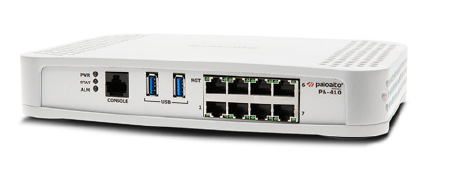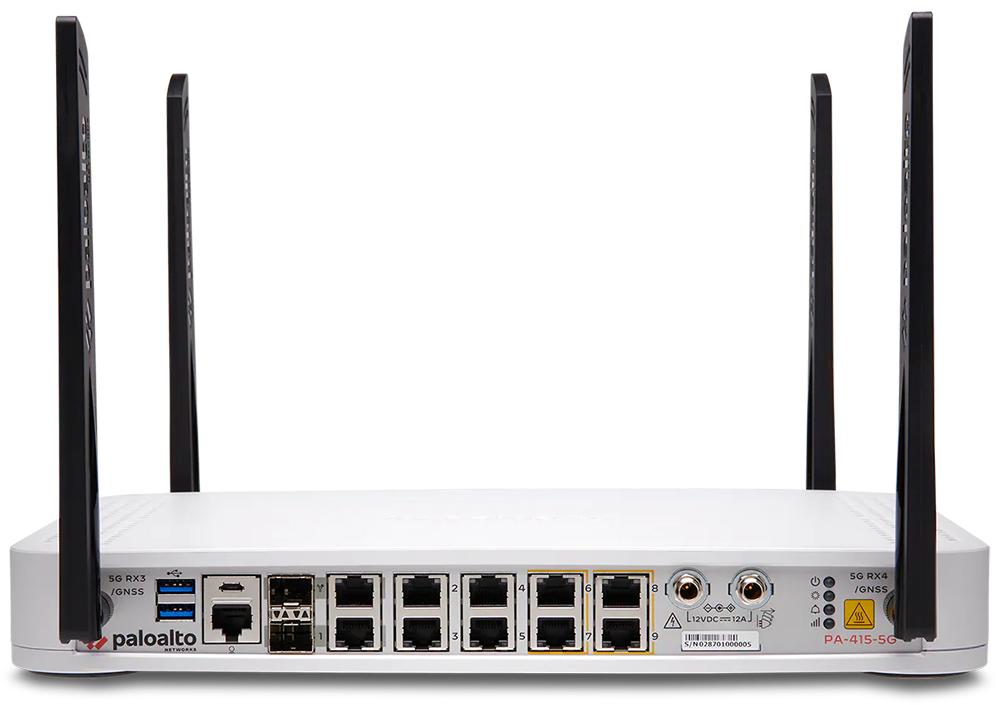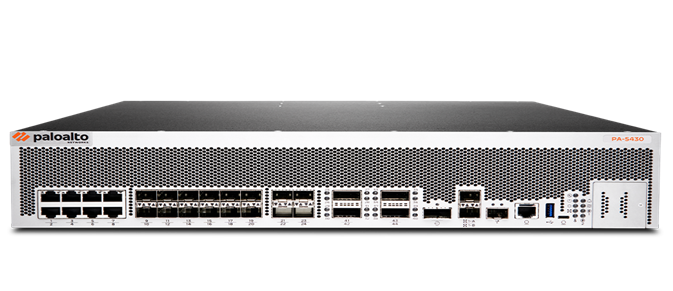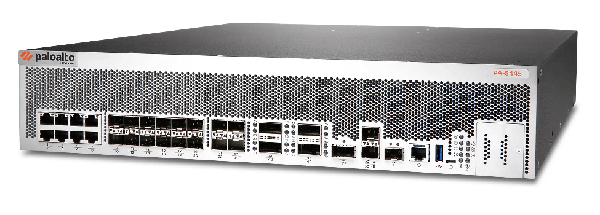
Compare Firewall Products
PA-400 Series:
| PA-410 | PA-415 | PA-415-5G | |||
|---|---|---|---|---|---|
 |
 |
 |
|||
| Performance i | |||||
| App-ID firewall throughput | 1.4 Gbps | 1.5 Gbps | 1.5 Gbps | ||
| Threat prevention throughput | 0.8 Gbps | 0.8 Gbps | 0.8 Gbps | ||
| IPsec VPN throughput | 650 Mbps | 650 Mbps | 650 Mbps | ||
| Connections per second | 11,000 | 11,000 | 11,400 | ||
| Sessions | |||||
| Max sessions (IPv4 or IPv6) | 64,000 | 64,000 | 64,000 | ||
| Policies | |||||
| Security rules | 500 | 500 | 500 | ||
| Security rule schedules | 256 | 256 | 256 | ||
| NAT rules | 400 | 400 | 400 | ||
| Decryption rules | 100 | 100 | 100 | ||
| App override rules | 100 | 100 | 100 | ||
| Tunnel content inspection rules | 100 | 100 | 100 | ||
| SD-WAN rules | 100 | 100 | 100 | ||
| Policy based forwarding rules | 100 | 100 | 100 | ||
| Captive portal rules | 10 | 10 | 10 | ||
| DoS protection rules | 100 | 100 | 100 | ||
| Security Zones | |||||
| Max security zones | 25 | 25 | 25 | ||
| Objects (addresses and services) | |||||
| Address objects | 2,500 | 2,500 | 2,500 | ||
| Address groups | 125 | 125 | 125 | ||
| Members per address group | 2,500 | 2,500 | 2,500 | ||
| Service objects | 1,000 | 1,000 | 1,000 | ||
| Service groups | 250 | 250 | 250 | ||
| Members per service group | 500 | 500 | 500 | ||
| FQDN address objects | 2,000 | 2,000 | 2,000 | ||
| Max DAG IP addressesii | 1,000 | 1,000 | 1,000 | ||
| Tags per IP address | 32 | 32 | 32 | ||
| Security Profiles | |||||
| Security profiles | 75 | 75 | 75 | ||
| App-ID | |||||
| Custom App-ID signatures | 6,000 | 6,000 | 6,000 | ||
| Shared custom App-IDs | 512 | 512 | 512 | ||
| Custom App-IDs (virtual system specific) | 6,416 | 6,416 | 6,416 | ||
| User-ID | |||||
| IP-User mappings (management plane) | 512,000 | 512,000 | 512,000 | ||
| IP-User mappings (data plane) | 128,000 | 128,000 | 128,000 | ||
| Active and unique groups used in policyiii | 1,000 | 1,000 | 1,000 | ||
| Number of User-ID agents | 100 | 100 | 100 | ||
| Monitored servers for User-ID | 100 | 100 | 100 | ||
| Terminal server agents | 400 | 400 | 400 | ||
| Tags per Useriv | 32 | 32 | 32 | ||
| SSL Decryption | |||||
| Max SSL inbound certificates | 25 | 25 | 25 | ||
| SSL certificate cache (forward proxy) | TBD | TBD | TBD | ||
| Max concurrent decryption sessions | 6,600 | 6,600 | 6,600 | ||
| Decryption Port Mirror | Yes | Yes | Yes | ||
| Network Packet Broker | No | No | No | ||
| HSM Supported | No | No | No | ||
| URL Filtering | |||||
| Total entries for allow list, block list and custom categories | 25,000 | 25,000 | 25,000 | ||
| Max custom categories | 2,849 | 2,849 | 2,849 | ||
| Max custom categories (virtual system specific) | 500 | 500 | 500 | ||
| Dataplane cache size for URL filtering | TBD | TBD | TBD | ||
| Management plane dynamic cache size | TBD | TBD | TBD | ||
| EDL | |||||
| Max number of custom lists | 30 | 30 | 30 | ||
| Max number of IPs per system | 50,000 | 50,000 | 50,000 | ||
| Max number of DNS Domains per system | 50,000 | 50,000 | 50,000 | ||
| Max number of URL per system | 50,000 | 50,000 | 50,000 | ||
| Shortest check interval (min) | 5 | 5 | 5 | ||
| Interfaces | |||||
| Mgmt - out-of-band | 10/100/1000, RJ45/Micro USB console | SFP/RJ45 combo, RJ45/Micro USB console | SFP/RJ45 combo, RJ45/Micro USB console | ||
| Mgmt - 10/100/1000 high availability | NA | NA | NA | ||
| Mgmt - 40Gbps high availability | NA | NA | NA | ||
| Mgmt - 10Gbps high availability | NA | NA | NA | ||
| Traffic - 10/100/1000 | 7 | 8 | 8 | ||
| Traffic - 10M/100M/1G/2.5G/5G | NA | NA | NA | ||
| Traffic - 100/1000/10000 | NA | NA | NA | ||
| Traffic - 1Gbps SFP | NA | 1 (SFP/RJ45 Combo) | 1 (SFP/RJ45 Combo) | ||
| Traffic - 10Gbps SFP+ | NA | NA | NA | ||
| Traffic - 25Gbps SFP28 | NA | NA | NA | ||
| Traffic - 40/100Gbps QSFP+/QSFP28 | NA | NA | NA | ||
| 802.1q tags per device | 4,094 | 4,094 | 4,094 | ||
| 802.1q tags per physical interface | 4,094 | 4,094 | 4,094 | ||
| Max interfaces (logical and physical) | 1,024 | 1,024 | 1,024 | ||
| Maximum aggregate interfaces | 3 | 3 | 3 | ||
| Maximum SD-WAN virtual interfaces | 300 | 300 | 300 | ||
| Power Over Ethernet | |||||
| PoE Enabled Interfaces | NA | 4 | 4 | ||
| PoE Interface Speed | NA | 1G | 1G | ||
| Total Power Budget | NA | 91 Watts | 91 Watts | ||
| Max Power per single port | NA | 60 Watts | 60 Watts | ||
| Cellular Interface | |||||
| 5G | NA | NA | 1 | ||
| Virtual Routers | |||||
| Virtual routers | 3 | 3 | 3 | ||
| Virtual Wires | |||||
| Virtual wires | 512 | 512 | 512 | ||
| Virtual Systems | |||||
| Base virtual systems | 1 | 1 | 1 | ||
| Max virtual systemsv | 1 | 1 | 1 | ||
| Routing | |||||
| IPv4 forwarding table sizevi | 5,000 | 5,000 | 5,000 | ||
| IPv6 forwarding table sizevi | 2,500 | 2,500 | 2,500 | ||
| System total forwarding table size | 5,000 | 5,000 | 5,000 | ||
| Max route maps per virtual router | N/A | N/A | N/A | ||
| Max routing peers (protocol dependent) | 500 | 500 | 500 | ||
| Static entries - DNS proxy | 1,024 | 1,024 | 1,024 | ||
| Bidirectional Forwarding Detection (BFD) Sessions | Yes | Yes | Yes | ||
| L2 Forwarding | |||||
| ARP table size per device | 1,500 | 1,500 | 1,500 | ||
| IPv6 neighbor table size | 1,500 | 1,500 | 1,500 | ||
| MAC table size per device | 1,500 | 1,500 | 1,500 | ||
| Max ARP entries per broadcast domain | 1,500 | 1,500 | 1,500 | ||
| Max MAC entries per broadcast domain | 1,500 | 1,500 | 1,500 | ||
| NAT | |||||
| Total NAT rule capacity | 400 | 400 | 400 | ||
| Max NAT rules (static)vii | 400 | 400 | 400 | ||
| Max NAT rules (DIP)viii | 400 | 400 | 400 | ||
| Max NAT rules (DIPP) | 200 | 200 | 200 | ||
| Max translated IPs (DIP) | 16,000 | 16,000 | 16,000 | ||
| Max translated IPs (DIPP)ix | 200 | 200 | 200 | ||
| Default DIPP pool oversubscriptionx | 2 | 2 | 2 | ||
| Address Assignment | |||||
| DHCP servers | 3 | 3 | 3 | ||
| DHCP relaysxi | 500xiii | 500xiii | 500 | ||
| Max number of assigned addresses | 64,000 | 64,000 | 64,000 | ||
| High Availability | |||||
| Devices supported | 2 | 2 | 2 | ||
| Max virtual addresses | 32 | 32 | 32 | ||
| QoS | |||||
| Number of QoS policies | 1,000 | 1,000 | 1,000 | ||
| Physical interfaces supporting QoS | 8 | 8 | 8 | ||
| Clear text nodes per physical interface | 31 | 31 | 31 | ||
| DSCP marking by policy | Yes | Yes | Yes | ||
| Subinterfaces supported | System Limit | System Limit | System Limit | ||
| IPSec VPN | |||||
| Max IKE Peers | 1,000 | 1,000 | 1,000 | ||
| Site to site (with proxy id) | 1,000 | 1,000 | 1,000 | ||
| SD-WAN IPSec tunnels | 1,000 | 1,000 | 1,000 | ||
| GlobalProtect Client VPN | |||||
| Max tunnels (SSL, IPSec, and IKE with XAUTH) | 250 | 250 | 250 | ||
| GlobalProtect Clientless VPN | |||||
| Max SSL tunnels | 20 | 20 | 20 | ||
| Multicast | |||||
| Replication (egress interfaces) | 100 | 100 | 100 | ||
| Routes | 500 | 500 | 500 | ||
Note:
i. 1. Firewall throughput measured with App-ID and User-ID features enabled utilizing AppMix transactions.
2. Threat prevention throughput measured with App-ID, User-ID, IPS, antivirus and anti-spyware features enabled utilizing AppMix transactions.
3. New sessions per second measured with 1 byte HTTP transactions. Additionally, for VM models, please refer to hypervisor, cloud specific data sheet for associated performance.
ii. System wide capacity
iii. Aggregate of LDAP groups, XML API Groups and Dynamic User Groups
iv. Only valid for PAN-OS 9.1 and above
v. Additional licenses are required for virtual system capacities above the base virtual systems capacity
vi. Entries shared across virtual routers
vii. Configuring static NAT rules to full capacity requires that no other NAT rule types are used.
viii. Configuring DIP NAT rules to full capacity requires that no other NAT rule types are used.
ix. DIPP translated IP capacity is proportional to the DIPP pool oversubscription value. The capacity shown here is based on an oversubscription value of 1x.
x. Source IP and source port reuse across concurrent sessions
xi. Maximum capacity represents total DHCP servers and DHCP relays combined
xii. Requires PAN-OS 11.0.2 or above
xiii. Total includes number of DHCP servers and DHCP relays
xiv. Capacity based on SMC model capacity
xv. Maximum cache entries supported with high capacity NPC cards
xvi. Maximum sessions supported with high capacity NPC cards
xvii. Standard memory NPC / XM or 100G NPC












